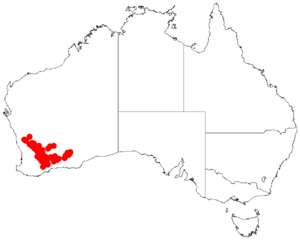Acacia dissona facts for kids
Quick facts for kids Acacia dissona |
|
|---|---|
| Scientific classification | |
| Genus: |
Acacia
|
| Species: |
dissona
|
 |
|
| Occurrence data from AVH | |
Acacia dissona is a type of shrub. It belongs to the Acacia family, also known as wattles. This plant is special because it grows only in a certain part of south-western Australia. This means it is "endemic" to that area.
What Does Acacia dissona Look Like?
This shrub usually grows between 0.5 to 2 metres (2 to 7 ft) tall. Its branches are often twisted and have small hairs. Like many Acacia species, it has phyllodes instead of true leaves. Phyllodes are flattened leaf stems that act like leaves.
The phyllodes of Acacia dissona are always green. They stand upright and are quite straight. Each one is about 2 to 4 cm (0.79 to 1.57 in) long and 1 to 1.5 mm (0.039 to 0.059 in) wide. They narrow down to a sharp, stiff point.
This plant blooms from July to October. It produces bright yellow flowers. The flowers grow in pairs in the axils (where a leaf meets the stem). They form round flower-heads, about 5 to 6 mm (0.20 to 0.24 in) across. Each head has 15 to 20 golden flowers.
After flowering, the plant grows long, thin seed pods. These pods are slightly bumpy where each seed is. They are gently curved and can be up to 6 cm (2.4 in) long. The pods are about 2.5 mm (0.098 in) wide. Inside, the seeds are shiny and dark brown. They are shaped like an oval and are about 2.5 to 4.5 mm (0.098 to 0.177 in) long and 1.5 mm (0.059 in) wide.
How Was Acacia dissona Named?
Scientists Richard Sumner Cowan and Bruce Maslin first officially described this plant. They did this in 1995. Their work was part of a study on different Acacia species. It was published in a science journal called Nuytsia.
There are two types, or "varieties," of Acacia dissona that scientists recognize:
- Acacia dissona var. dissona
- Acacia dissona var. indoloria
Where Does Acacia dissona Grow?
Acacia dissona is native to Western Australia. It grows in areas like the Wheatbelt and Goldfields-Esperance regions. You can often find it on flat or gently rolling plains. It prefers sandy, clay, or loamy soils.
This plant is found in different spots across the region. Its distribution is "discontinuous," meaning it's scattered. You can find it from Coorow in the north-west to Ongerup in the south-west. It also grows near Southern Cross in the north-east and Norseman in the south-east.

